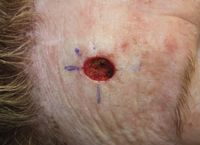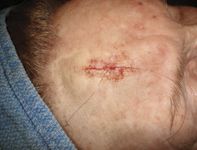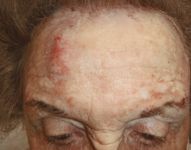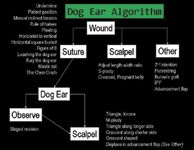- General Dermatology
- Eczema
- Chronic Hand Eczema
- Alopecia
- Aesthetics
- Vitiligo
- COVID-19
- Actinic Keratosis
- Precision Medicine and Biologics
- Rare Disease
- Wound Care
- Rosacea
- Psoriasis
- Psoriatic Arthritis
- Atopic Dermatitis
- Melasma
- NP and PA
- Skin Cancer
- Hidradenitis Suppurativa
- Drug Watch
- Pigmentary Disorders
- Acne
- Pediatric Dermatology
- Practice Management
- Prurigo Nodularis
Article
Novel algorithm prevents, tames dog-ears
Because dog-ears behave predictably, physicians can use a structured algorithm to prevent, minimize and repair them when necessary, the algorithm's developer says.

Key Points

Synonyms for the term dog-ear include "pooch," cat ear, Burow's triangle, tri-cone, redundant tissue cone, standing cone deformity, tissue mound, and skin buckling, puckering or tenting, says T. Minsue Chen, M.D., a Pasadena, Texas, private practitioner who spoke at the 68th Annual Meeting of the American Academy of Dermatology.

Dog-ears tend to form if a wound's apical angle is greater than 30 degrees, Dr. Chen says. "It's been calculated that if you have a wound angle that's less than 30 degrees, a dog ear should not develop," she says.

"No wonder we're having problems with dog-ears. This 30 degree error is pervasive throughout our dermatologic surgery literature," she adds.
To achieve a 30 degree angle using geometric principles, "We must extend the length-to-width ratio to 5-to-1," Dr. Chen explains.
Wound edges of unequal lengths also can result in dog-ears.

The right design
Excising dog-ears successfully requires choosing the right surgical design. "Think of the dog-ear like a mountain," Dr. Chen says.
For a traditional triangular excision, "We want to go around the mountain, not over it, then down to the apex. If we go over the mountain, the dog-ear will remain," she explains.
More specifically, Dr. Chen avers, "I start off by grabbing the apex of the pooch and pulling it perpendicularly away from the skin. With gentian violet, I draw around the base of the pooch, including the apical angle. Then, make sure you apply even, symmetrical tension. If you have an assistant, make sure the assistant is pulling in the direction of the wound rather than off to one side, because that can cause you to create a jagged, irregular line when you're cutting."
For cutting, she recommends a scalpel. "I find that scissors, especially curved ones, will create a beveled wound edge and leave extra tissue."

Not all dog-ears are amenable to triangular excision, which requires cutting directly inferiorly or superiorly to the defect. "Sometimes you want a wound edge of a shorter length," Dr. Chen says. "I find the description of M-plasty design in textbooks to be too 'cookie-cutter.' It doesn't account for the different tissue characteristics involved."
Using one-size-fits-all M-plasty results in dog-ears that are too large or too small, Dr. Chen says. To avoid these problems, "I draw the planned excision halfway to the apex, not all the way, as in triangular excision." After cutting, undermining and re-draping the flap, "Have your assistant pull one corner, and then you'll pull the other as you excise from the midpoint of the flap to the apex of each side," she says.





